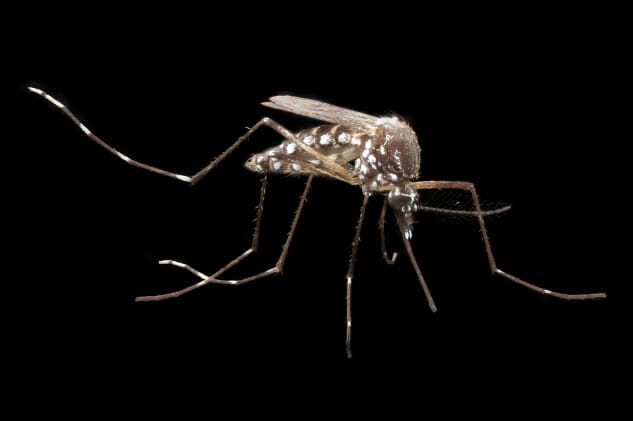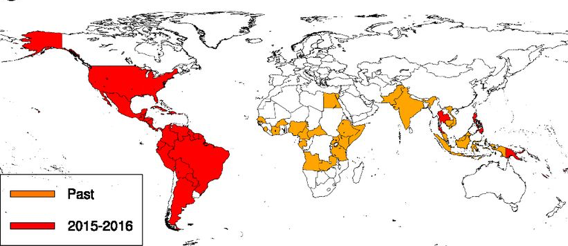Warming Signs: Climate Change Means More Mosquito-borne Illnesses Like Zika
Science Features Disease
Often, when we talk about climate change, it seems like a far-off scenario. We talk in terms of saving the planet for future generations and predict disruptive sea level rise within the century. But the effects of climate change are already felt around the world; future changes will only intensify them.
![]()
In 2015, researchers made a startling discovery: a new kind of blood-sucker was living year-round in Washington, D.C. The Aedes aegypti mosquito carries diseases like West Nile Virus, dengue, chikungunya and, of late, Zika. Previously, the mosquito wasn’t known to live full-time any farther north than South Carolina—but it migrated up to Capitol Hill for year-round residence around 2011 or even earlier.
Mosquitoes are just warming up
The past three years have successively broken records as the hottest on record, and warmer conditions during the concurrent El Nino event didn’t help. Hotter conditions, changes in rainfall (including flooding and drought) and human migration have all hastened the spread of mosquito-borne diseases.
A 2015 report found the Aedes mosquito range expansion “to be the widest ever recorded; now extensive in all continents, including North America and Europe.” More research examining the potential risk of expanded mosquito habitats found that half a billion people could be at risk of diseases borne by this mosquito alone by 2061-80.
Climate change doesn’t just mean we’ll see different species of mosquitoes in new places; it also means they’ll likely become more active—and therefore more infectious. Simply increasing the temperature also “boosts their rates of reproduction and the number of blood meals they take, prolongs their breeding season, and shortens the maturation period for the microbes they disperse,” Harvard’s Paul Epstein wrote in 2005.
Basically, warmer temperatures inspire the mosquitoes to have more sex, eat more and return to work more efficient. (Just like that vacation you took to the Caribbean.) Mosquito season is also lasting longer—in some places, as much as 76 percent. Baltimore, Minneapolis, and cities in North and South Carolina are seeing some of the biggest changes in their mosquito seasons since the 1980s.
Humans aren’t adapting as quickly
While diseases like Zika have been around for decades, they’re new in many of these neighborhoods—and us humans haven’t had time to fight them off.
“These expansions are putting at risk large human populations that never experienced aegypti-borne viruses and therefore have no immune defenses against them,” Jeffrey R. Powell wrote in Science. “This greatly increases the likelihood of severe epidemics.”
It’s not just Zika Graph courtesy of Caminade et al. Global risk model for vector-borne transmission of Zika virus reveals the role of El Niño 2015
Graph courtesy of Caminade et al. Global risk model for vector-borne transmission of Zika virus reveals the role of El Niño 2015
Countries in Africa and Asia didn’t see dramatic increases in Zika infections because many of those regions have developed immunity to a disease that has circulated there for decades. However, India has struggled with a huge surge in dengue cases in recent years, and yellow fever also resurged in several African countries recently.
Diseases spread by insects and parasites account for more than 17 percent of all infectious disease cases, and cause more than a million deaths each year, the World Health Organization reports. Lyme disease and malaria are also examples of infections spread by critters moving into new habitats as the environment around them changes.
WHO draws explicit links between these changes in insect-borne diseases and climate. “Changes in infectious disease transmission patterns are a likely major consequence of climate change,” one report states. The organization estimates that a temperature increase of 2 or 3ºC would put several million more people at risk of malaria alone.
Why would a drought make it worse?
Mosquitoes breed in pools of water, so it’s not surprising that increased rainfall and flooding would mean more bugs buzzing around us. But droughts, paradoxically, also mean more mosquitoes.
“If you have a drought, you don’t have reliable water access, and that makes you go and get water and store,” Sadie Ryan, a medical geographer at the University of Florida, told Climate Central. “By storing it, you’re creating mosquito habitat.”
Humans are migrating more, too
The fact that Zika appeared in the U.S. has more to do with international travel than migrating mosquitoes. Travelers brought the disease into the country—but because the Aedes aegypti mosquito now thrives in new regions, they picked up the disease and spread it locally.
Global travel and trade makes it trickier to predict how climate change will affect the spread of diseases. Furthermore, it’s not as simple as a region suddenly being warm enough to host the new mosquito. There are other factors at play—including competition from other mosquitoes, differences in how humans interact, weather and other variables.
For instance, researchers studying dengue transmission found that rates were lower in Texas than they were across the border in Mexico because of more sealed-up air-conditioned buildings, less exposure to the great outdoors, and differing socioeconomic factors.
Is it all bad news?
The problem may be complicated, but some of the solutions are pretty simple. Eradicating pools of water is always a good idea when you want prevent mosquitoes from breeding. Quickly dealing with erratic rainfall, including floods and droughts, will be key in addressing future outbreaks of mosquito-borne illnesses.
Avoidance, of course, also helps. Old-fashioned solutions like applying mosquito repellent, wearing long sleeves and pants, and even installing mosquito nets can reduce your exposure to mosquitoes—and thus to new viruses. And while air-conditioning comes with its own environmental problems, keeping your house sealed does help keep the bugs away. A lower-impact solution might be to make sure you don’t have any holes in the screens on your windows and doors.
While international travel and trade may have introduced Zika into new zones—first, in South America, and later in the U.S.—it’s important to recognize that migration itself can be the result of climate change. By addressing the underlying conditions that make us more vulnerable to climate change and the spread of disease, we might circumvent future problems.
Top photo courtesy of Army Medicine
Melody Schreiber is a freelance journalist based in Washington, D.C.